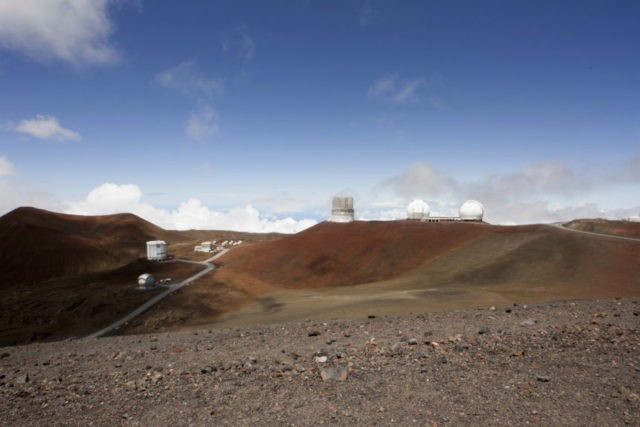HONOLULU (AP) — A long-running effort to build one of the world’s largest telescopes on a mountain sacred to Native Hawaiians is moving forward after a key approval Thursday, reopening divisions over a project that promises revolutionary views into the heavens but has drawn impassioned protests over the impact to a spiritual place.
Hawaii’s land board granted a construction permit for the $1.4 billion Thirty Meter Telescope atop the state’s tallest mountain, called Mauna Kea, but opponents vowed to keep fighting. Protesters willing to be arrested were successful in blocking construction in the past.
“For the Hawaiian people, I have a message: This is our time to rise as a people,” said Kahookahi Kanuha, a protest leader. “This is our time to take back all of the things that we know are ours. All the things that were illegally taken from us.”
Opponents can appeal the decision, but it wasn’t immediately clear what they plan to do. Project officials didn’t immediately comment or discuss plans for construction.
Richard Ha, a Native Hawaiian farmer who supports the project, urged avoiding confrontation.
“The possibility of getting the best telescope in the world … I don’t feel is the right battle to fight,” he said. “It will hurt our own people.”
While opponents say constructing the telescope will desecrate Mauna Kea, supporters tout the instrument’s ability to provide long-term educational and economic opportunities.
“This was one of the most difficult decisions this board has ever made,” state Board of Land and Natural Resources Chairwoman Suzanne Case said in a statement about the 5-2 decision.
Plans for the project date to 2009, when scientists selected Mauna Kea after a five-year around-the-world campaign to find the ideal site for what telescope officials said “will likely revolutionize our understanding of the universe.”
The project won a series of approvals from Hawaii, including a permit to build on conservation land in 2011. Protesters blocked attempts to start construction. Then in 2015, the state Supreme Court invalidated the permit, saying the board’s approval process was flawed, and ordered the project to go through the steps again.
Protests disrupted a groundbreaking in 2014 and intensified after that. Construction stopped in 2015 after 31 demonstrators were arrested for blocking the work.
A second attempt to restart construction a few months later ended with more arrests and crews retreating.
Mehana Kihoi said being arrested while praying on the mountain was one of the most traumatic experiences of her life. She started going there to help heal from domestic violence, Kihoi told the land board earlier this month.
“For years, I carried grief and pain … until I went to the mauna,” she said, using the Hawaiian word for mountain.
Some say fighting the telescope has awakened a new generation of Hawaiian activism, with Kanuha, the protest leader, telling the board that Native Hawaiians “will determine what places are sacred and how they should be protected.”
Kanuha dismissed the millions that telescope officials have paid toward educating youth on the Big Island in science, technology, engineering and math. So far, $3.5 million has been paid into the educational fund, even while the project’s construction permit was invalid.
That money isn’t the answer to improving the lives of Native Hawaiian youth, Kanuha said. Revitalization of language and culture through Hawaiian-focused education is what’s important, he said.
A group of Native Hawaiian telescope supporters formed a group called Perpetuating Unique Educational Opportunities. Some members had been against the telescope in the past, said the group’s attorney, Lincoln Ashida.
“We believe that with increased opportunities for children, that results in stronger families, which in turn benefits our community,” Ashida told the board.
A group of universities in California and Canada make up the telescope company, along with partners from China, India and Japan. Its primary mirror would measure 30 meters in diameter and be made up of 492 individual segments. Compared with the largest existing visible-light telescope in the world, it would be three times as wide, with nine times more area.
Mauna Kea, a dormant volcano, has been the first choice, telescope officials said, calling it the best location in the world for astronomy. Its summit provides a clear view of the sky for 300 days a year, with little air and light pollution. They selected an alternate site in Spain’s Canary Islands if the telescope couldn’t be built in Hawaii.
After 44 days of recent testimony before the state land board, a retired judge overseeing the hearing recommended granting the permit, with conditions that employees attend mandatory cultural and natural resources training and that employment opportunities be filled locally “to the greatest extent possible.”

COMMENTS
Please let us know if you're having issues with commenting.